Growing Tulips in Pots: A Complete Guide
A Complete Guide to Container Gardening with Tulips
For gardening enthusiasts who crave the vibrant splashes of colour that tulips bring, but are constrained by the limits of space, growing tulips in pots presents a delightful solution. This method of container gardening is perfect for those with compact living spaces, such as apartments with balconies or homes with small patios.
Whether you’re a seasoned green thumb or a budding enthusiast, embarking on the journey of growing tulips in containers promises a rewarding spectacle of bloom and beauty. Embrace the art of container gardening with tulips, and transform your space into a canvas of perennial joy and seasonal colour.
Choosing the Right Tulip Varieties for Pots
The secret to a stunning display of tulips in pots lies in selecting the right varieties. Tulips, in their glorious diversity, offer a palette of colours, shapes, and sizes, making certain types more suited to the confines of container gardening than others.
When choosing tulip bulbs for pots, consider the following varieties renowned for their adaptability, resilience, and aesthetic appeal:
- Triumph Tulips: Celebrated for their robust stems and beautiful hues, triumph tulips are the go-to choice for a mid-spring spectacle. Their sturdy nature makes them ideal for withstanding the variable conditions of container living.
- Tulip Daytona: Known for their unique, fringed petal edges, these tulips add an element of texture and depth to your container garden. Their distinctive look makes a bold statement in any setting.
- Parrot Tulips: With flamboyant, ruffled petals resembling a parrot’s plumage, parrot tulips are a feast for the eyes. Though they require a bit more care, their dramatic appearance is well worth the effort.
When planning your tulip container garden, also take into account the climate you’re in. While tulips generally prefer cooler spring temperatures, some varieties are more tolerant of warmer or fluctuating climates. Ensuring the right match between tulip variety and your local environment will set the stage for a flourishing display.
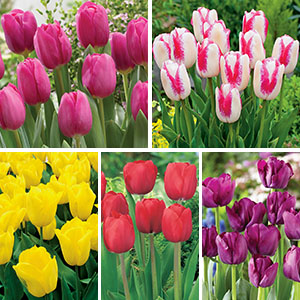
Tulip Triumph Collection-Bold Colours – Garden Express Australia
Selecting the Perfect Container
Choosing the right container is just as crucial as selecting the tulip variety when it comes to growing tulips in pots. The container not only serves as the home for your tulips but also plays a pivotal role in their health and the overall aesthetic appeal of your garden display.
Size
Tulips need enough space to develop a strong root system. Opt for containers that are at least 20cm deep and wide enough to accommodate the number of bulbs you plan to plant, keeping in mind that tulips look best when grouped together. This depth provides ample space for proper root growth and stability.
Drainage
Good drainage is essential to prevent water from pooling at the bottom of the container, which can cause bulb rot. Ensure your container has one or more drainage holes at the bottom. If necessary, increase drainage efficiency by adding a layer of gravel or broken pottery pieces at the base of the pot.
Material
Containers made from terracotta or clay offer excellent breathability, helping to regulate soil moisture and temperature. Plastic and resin pots are lightweight and retain moisture longer, which can be beneficial in warmer climates. Metal and wooden containers can add unique aesthetic value but may require additional drainage modifications.
Aesthetics
The container’s appearance should complement the beauty of the tulips and match your personal style. From sleek and modern designs to rustic or ornate classics, choose a container that enhances the visual impact of your tulip display.
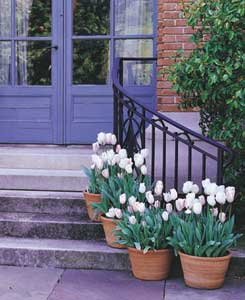
Growing Spring Bulbs in Pots – Garden Express Australia
Best Soil for Tulips in Pots
The success of growing tulips in containers significantly depends on the soil quality. Tulips flourish in well-draining soil that provides the right balance of nutrients and moisture:
Well-Draining Mix
Start with a high-quality potting mix designed for container gardening. These mixes usually contain perlite or vermiculite to improve drainage and aeration, creating an ideal environment for tulip bulbs.
Nutrient Content
While tulips are not heavy feeders, incorporating a slow-release fertiliser or compost into the potting mix can provide them with essential nutrients for healthy growth and vibrant blooms. Choose a fertiliser with a balanced N-P-K ratio or one slightly higher in phosphorus to promote strong root development and blooming.
pH Balance
Tulips prefer slightly acidic to neutral soil, with a pH range between 6.0 and 7.0. If you’re unsure of your potting mix’s pH, test it using a soil pH test kit. Adjust the pH accordingly by incorporating sulphur to lower it or lime to raise it.
By carefully selecting the appropriate container and preparing the best soil environment, you’re setting the stage for your tulips to thrive and bloom spectacularly in pots.
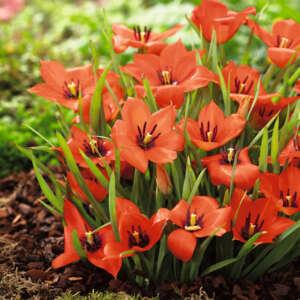
Garden Express Australia
Planting Tulip Bulbs in Pots
Planting tulip bulbs correctly in containers is a straightforward but crucial step for ensuring a beautiful spring display. Follow these guidelines to create a flourishing tulip garden:
Timing
The ideal time for planting tulip bulbs in pots is in the fall, several weeks before the ground freezes. This timing allows the bulbs to establish roots in the cooler months, preparing them for a vibrant bloom in the spring.
Preparing Your Container
Begin with a clean container with adequate drainage. Cover the drainage holes with a layer of gravel or mesh to prevent soil loss while ensuring water can escape.
Soil Preparation:
Fill your container with the pre-mixed, well-draining potting soil until it’s about three-quarters full. For added nutrients, mix in a handful of slow-release bulb fertiliser or bone meal.
Bulb Placement
Set the tulip bulbs on the soil surface, with the pointy end facing up. Space them about 12cm apart for optimal growth. For a denser display, you can place them closer together, but they should not touch.
Covering the Bulbs
Add more potting mix over the bulbs until the container is nearly full, leaving some space at the top for watering. Water thoroughly after planting to settle the soil around the bulbs.
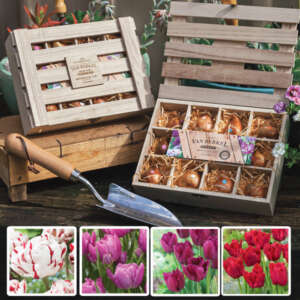
Garden Express Australia
Care and Maintenance of Tulips in Pots
Once your tulips are planted, a little ongoing care will ensure they grow healthy and bloom beautifully:
Watering
Tulips in pots require consistent moisture, but it’s crucial to avoid overwatering. Water when the top inch of soil feels dry to the touch, ensuring the soil is moist but not waterlogged.
Sunlight
Tulips thrive in full to partial sunlight. Place your pots in a location where they can receive at least 6 hours of direct sunlight daily. If sunlight is limited, rotating the pots periodically can help ensure even growth and blooming.
Feeding
Apply a low-nitrogen, high-potassium liquid fertiliser once the tulips start to flower to support vibrant blooms and healthy bulb development for the next year. Avoid high-nitrogen fertilisers, which can encourage leaf growth at the expense of flowers.
After Bloom Care
After the tulips have bloomed and the petals fall, cut back the flower stalks to prevent seed formation. Leave the foliage until it turns yellow and dies back naturally, as this process allows the bulbs to store energy for the next blooming season.
By following these planting and care tips, you’ll be well on your way to enjoying a stunning display of tulips in pots come spring. The effort you put into selecting the right bulbs, preparing your containers and soil, and providing ongoing care will be rewarded with vibrant colours and textures that brighten your outdoor or indoor spaces.
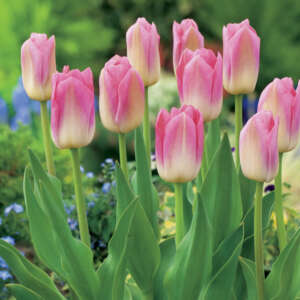
Tulip Dynasty – Garden Express Australia
Overwintering Potted Tulips
In regions with cold winters, special attention is needed to protect tulip bulbs in pots from freezing temperatures. Here’s how to ensure your tulips survive the winter and bloom beautifully in spring:
Insulation
Wrap pots in bubble wrap, burlap, or hessian to insulate them against cold. This extra layer of protection can make a significant difference in temperature within the pot, safeguarding the bulbs.
Sheltered Storage
Move the pots to a sheltered location, such as a garage, shed, or against a south-facing wall, where they’re protected from wind and severe frost. Ensure the location is cool enough to maintain dormancy but not so cold that the bulbs freeze.
Ground Planting Option
For added protection, you can bury the pot in the ground in a garden bed. The earth provides natural insulation. Remember to dig it up once the risk of severe frost has passed in early spring.
Watering
Reduce watering as the weather cools and stop entirely once you’ve moved the pots to their winter location. Bulbs in dormancy require minimal moisture, and too much water can lead to rot.
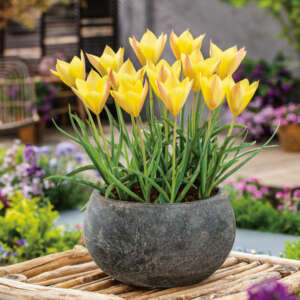
Tulip Batalinii Honky Tonk – Garden Express Australia
The Joy of Tulips in Containers
Growing tulips in pots is a rewarding endeavour that brings the joy of spring to any space, large or small. By selecting the right varieties, preparing your containers and soil carefully, and following through with appropriate care and overwintering measures, you can enjoy the stunning beauty of tulips year after year. Garden Express has a stunning tulip range that is sure to bring joy and colour to your next gardening adventure.
FAQ: Growing Tulips in Pots and Containers
- Can tulips be replanted in pots every year?
Yes, tulips can be replanted annually. For non-perennial varieties, it’s often best to start with fresh bulbs each fall for optimal bloom.
- How many tulip bulbs should I plant in a pot?
The number of bulbs per pot depends on the pot’s size and the bulbs’ size. As a general rule, space bulbs about 12cm apart to allow for enough room for growth.
- Do tulips in pots need special soil?
Tulips thrive in well-draining soil with good aeration. A high-quality potting mix designed for bulbs or container gardening works best.
- Can I force tulips to bloom indoors?
Yes, by simulating winter conditions. Place potted bulbs in a cool, dark place for 12–16 weeks before moving them to a warmer, brighter spot to encourage blooming.
- Can tulips be grown in containers successfully?
Absolutely, growing tulips in containers is a fantastic way to enjoy their beauty, especially in spaces where garden beds may not be available. With proper care, including selecting the right pot and soil mix, tulips can thrive and bring a splash of colour to your patio, balcony, or indoors.
- What’s the best way to plant tulip bulbs in pots?
To plant tulip bulbs in pots, choose a container with good drainage, fill it with a well-draining potting mix, and plant the bulbs with the pointy end up, about 12cm apart. Ensure the pot is deep enough to accommodate the bulbs’ growth – usually, a depth of about 20–25cm is ideal.
- How should I go about planting tulip bulbs in containers for spring blooms?
For a beautiful spring display, start planting tulip bulbs in containers in the fall. This allows the bulbs to establish themselves during the cooler months. Use a high-quality potting mix and ensure your containers have adequate drainage to prevent bulb rot.
- Can I plant tulip bulbs in pots and expect them to come back every year?
While some tulip varieties are perennial and may return for several years when planted in the ground, tulips grown in pots often perform best as annuals. For the best display, consider planting fresh bulbs each fall. However, you can try lifting and storing the bulbs after the foliage has died back to replant the next year.
Need expert advice or ready to start shopping? Contact Garden Express now and bring your tulip dreams to life!






